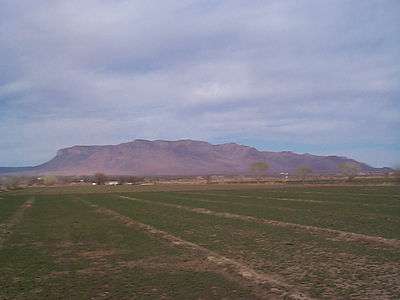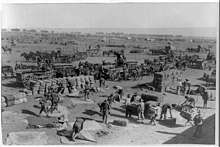Colonia Dublán

Colonia Dublán began as a Mormon colony, located in the state of Chihuahua, Mexico. It is now a part of Nuevo Casas Grandes Municipality. It is one of the few surviving Mormon colonies in Mexico (the other being Colonia Juárez).
History
The first Mormon pioneers arrived in Mexico in 1885, founding Colonia Díaz. In 1888, George M. Brown of Provo, Utah, made a deal with German-Mexican Lewis Huller for 73,000 acres (300 km2) of land north of what was then the Casas Grandes River. The colony, which was originally called Colonia Huller, was first settled by George Lake, a Mormon colonist, with many others following in the spring of 1889.[1] However, due to a problem with the deal between Brown and Huller, titles to the land could not be given to them. Instead, the colonists were forced to rent from locals or make their own individual purchases. When it was founded, the nearest train station to the colony was Gallego, 110 miles (180 km) away. Since a large percentage of goods consumed by the colony had to be imported from the United States, prices were high. In 1897, a railroad was built from Ciudad Juárez to a point twelve miles (19 km) outside of Dublán. The railroad proved extremely valuable for the colony, as goods could be cheaply imported and exported.[2]

In 1916, Colonia Dublan was chosen for the headquarters of the Pancho Villa Expedition for its proximity to the railroad.[3][4]
The community was also the birthplace of George W. Romney, governor of the U.S. state of Michigan and father of 2012 U.S. presidential candidate Mitt Romney.
Present day
Colonia Dublán is currently a very small town located just north of Nuevo Casas Grandes. Most of the remaining colonizers engage in agriculture and produce crops such as peaches, apples, pecans and chile. There is also significant production of wheat and cattle. Most members of the Mormon community are now of Mexican descent. The remaining descendants of the colonizers belong to the LDS Church and continue to serve a role within that church in Mexico.
Notes
- ↑ "Colonia Dublan". visitmormoncolonies.com. Archived from the original on March 18, 2010.
- ↑ Romney (1938), pp. 95-101
- ↑ Toulmin (1935), pp. 49, 91, 101, 115-116
- ↑ William G. Hartley, Lorna Call Alder & H. Lane Johnson, Anson Bowen Call: Bishop of Colonia Dublán, 2007, pp. 86-99.
References
- Hartley, William G. (2007). Anson Bowen Call: Bishop of Colonia Dublán. Provo, Utah: Lorna Call Alder. ISBN 1-928845-52-5.
- Romney, Thomas (1938). The Mormon colonies in Mexico. University of Utah Press. ISBN 0-87480-838-3.
- Toulmin, Colonel H. A., Jr. (1935). With Pershing In Mexico. The Military Service Publishing Co. Full text at https://babel.hathitrust.org/cgi/pt?id=uc1.$b23462;view=2up;seq=8
Coordinates: 30°26′N 107°54′W / 30.433°N 107.900°W